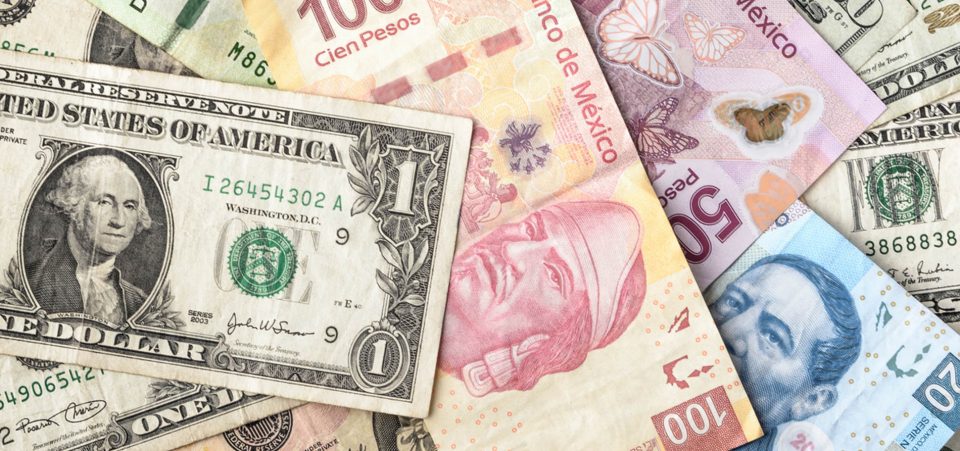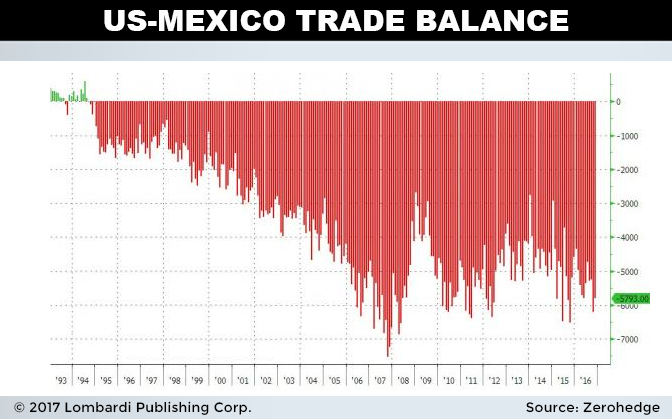Dour Mexican Peso Forecast for 2017
To say relations with America and Mexico have gone south is an understatement. Things are getting quite contemptuous, and this portends quite negative effects for the Mexican peso forecast.
The inauguration of the 45th President has done little to ratchet down tensions between neighbors. In a break away from traditional forms of communication, both leaders have taken to Twitter to convey their message.
Mexican President Enrique Peña Nieto quickly denounced President Donald Trump’s executive order actions on January 25 mandating the immediate construction of a wall on the border and the restriction of federal funding of sanctuary cities. “As a response, I have ordered Mexico’s Foreign Ministry to redouble the protection measures to our countrymen,” Peña Nieto said. “Mexico does not believe in walls,” he said. “I have said it time and time again; Mexico will not pay for a wall.” (Source: “Mexican Prez Speaks: ‘We Won’t Pay For A Wall’, Will Protect Migrants in U.S.,” Breitbart, January 26, 2017.)
President Nieto then proceeded to cancel a meeting with Trump scheduled for the week of January 30.
Not to be outdone, Donald Trump left no doubt on his stance on trade during his latest Tweet storm. “Mexico has taken advantage of the U.S. long enough. Massive trade deficits & little help on the very weak border must change, NOW!” (Source: “Trump Warns Mexico: “Taken Advantage Of US For Long Enough… Must Change Now,” Zero Hedge, January 27, 2017).
All this testiness between “allies” has done little to support a flagging peso, which is trading near all-time lows against the dollar.
What’s Next for U.S.-Mexico Relations?
This question is of major importance to the Mexican peso forecast, since a souring of relations could affect decisions made at the negotiating table. Of course, I’m referring to the upcoming North American Free Trade Agreement (NAFTA) renegotiation expected to take place in earnest. If Mexico walks away with little in concessions, this could have terrible consequences for the peso.
The market already expects $25.0 billion to $70.0 billion in annual Mexican capital surpluses (going back to 2000) will evaporate, so the devil is in the details. For example, can Mexico negotiate import trade exemptions on certain goods to maintain its price competitiveness in strategic markets? Agriculture comes to mind, where price increases on low margin goods would undoubtedly get passed on to consumers. After all, would you pay 20% more for bell peppers or avocados, or simply substitute them with domestic fruits and vegetables?
There are also questions surrounding the automobile sector. Mexico must maneuver not only around the import tax issue, but manufacturer relocation back to America. General Motors Company (NYSE:GM) and Ford Motor Company (NYSE:F) have already committed to move some production back to the U.S., so they’ll be fighting to keep as much market share as possible. Given Trump has focused a great amount of attention on wooing automakers back to U.S. soil, Mexico is in for a daunting challenge.
With such major economic ramifications on the line, why does Mexico keep poking the bee’s nest?
This goes back to pre-election, when former President and member of the Mexican intelligentsia, Vicente Fox, slammed Trump repeatedly. Fox called Trump “a crazy guy” and “a false prophet” who wasn’t fit to be president. (Source: “Former Mexico President Uses F-Word to Slam Donald Trump,” Fortune, February 26, 2016.)
Whether it be former president Vicente Fox, Felipe Calderon, or current President Nieto, the personal attacks have continued unabated. And this leads us to some very important questions. Have relations soured to such an extent that negotiating NAFTA in good faith is no longer possible? Will this animosity prompt Trump to go for the kill rather than simply seeking a fair deal for both sides?
For Mexico’s sake, it had better hope not.
Taking a step back for a moment, let’s examine whether Trump’s desire to renegotiate NAFTA is even a reasonable demand. The numbers would suggest a resounding “Yes.”
Since NAFTA came into force on January 1, 1994, U.S. trade deficits have exploded. The U.S. was actually running small balance of trade surpluses with Mexico in the two years preceding the agreement—but that all changed. Car manufacturers especially took advantage of cheaper labor and environmental costs by moving production to northern Mexican border states, then shipping cars back into America sans tariffs. Capital inflows (U.S. dollars) were flooding into the country at breakneck velocity.
This was all having a stabilizing effect on the Mexican peso outlook, which, in conjunction with a booming stock market, helped keep exchange rates stable between 3.00-3.45 USD/MXN in 1993/94. This, until the Mexican peso crisis, caused a sudden devaluation in late 1994, but that topic is for another day. The main point is that NAFTA was undeniably beneficial for the Mexican economy and balance of trade, as seen on the chart.
As such, we can understand why Mexico wants to keep the status quo in place at all costs. Unfortunately for Mexico, Donald Trump is on a mission to change the trade dynamics, and he’s holding all the aces.
Consider the U.S. accounts for 80% of total Mexican exports and you can see why. Mexico simply has no way to make up this slack exporting to the rest of the world. It may be able to forge new bilateral deals elsewhere, but nothing approaching the numbers needed to replace American trade. America’s trade is much more diversified and international.
Considering Mexico’s weak position in upcoming NAFTA negotiations, it is probably best served repairing relations as soon as possible while it still can. Trump has demonstrated he’ll follow through on his word, and he’s stated numerous times he seeks “fair” trade deals, not one-sided ones. Thus, it’s curious why Mexico is acting like the political pitbull, when in reality it is the chihuahua—all bark, no bite.
Mexican Peso Forecast for 2017
It’s all about expectations going forward. While there are few obvious catalysts for a strengthening Mexican peso forecast in the near term, upcoming NAFTA renegotiations will tell the tale.
Should the Mexican government negotiate a “fair” trade deal, one in which trade surpluses vanish but economic functioning doesn’t otherwise get upended, the peso may rally in the short term. However, if Trump goes for the kill and procures a deal that swings the economic pendulum too much towards America’s advantage, this could send the peso tanking. The last thing Mexico needs is budget surpluses turning into budget deficits, sparking capital flight where a weak economic growth and toothless rule-of-law already prevail. Memories of the Mexican Peso Crisis in 1994 still linger in the minds of many government officials.
Ever aware of this possibility, Mexico is reportedly recruiting mega-billionaire Carlos Slim to do its bidding. This is a good decision, considering Mexico’s political intelligentsia has shown no signs that it knows how to communicate with the current Trump regime. Perhaps a comparable alpha-male like Slim; one who speaks and understands the cutthroat business tactics Trump is employing, will stem the tide. This doesn’t shift leverage to Mexico’s side, however; Slim might be a useful firewall.
On the bright side, a neutral U.S.-Mexico balance of trade could mean Mexico might not “pay” for the wall after all. But somehow, we think Mexico would be quite content doing so.







